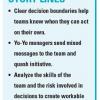 |
When Coders Control Companies Software developers are not typically at the top of the organizational chart. Yet in some cases, developers are able to wield their knowledge and control of the code to hold management hostage to the developers’ own agenda. How can you avoid being taken hostage and losing control of your company and its software?
|
|
 |
Tale of a Yo-Yo Manager There is much more to empowering your team than simply stating "You're empowered." Consider the three Ws of empowerment: "what," "when," and "why" when creating boundaries that define which decisions are the team's and which need management approval.
|
|
|
|
Keys to Top-Notch Estimates If the construction industry estimated projects as poorly as the IT industry does, we would still be living in mud huts. Yet inaccurate project estimates have become the norm in the software industry. Find out how you can turn your estimates into reasonable predictions of project performance.
|
|
|
|
A Culture of Trust So, you've been asked to take over the leadership of a struggling, disconnected team. Now what? Create a culture where the building of trust between team members is fostered, flourishes, and thrives--where people who have not begun to trust each other can discover the possibility.
|
|
 |
Exit, Stage Left Many technology workers are drawn to the industry from seemingly unrelated professions. Don't underestimate the importance of a liberal arts education and general life experiences to the technology field. These workers can bring a lot of value and wisdom to your team.
|
|
|
|
How to Fail with Agile A switch to agile often conflicts with personal career goals such as maintaining the status quo and working no harder than necessary. These twenty guidelines will help you sabotage your agile project, helping you fail quickly and spectacularly.
|
|
 |
Advice for the New Leader As a new manager it's easy to fall into the trap of taking on more of your team's responsibilities than you should. Learn how to guide your team to success by stepping back and letting team members solve their own problems, learn from their mistakes, and most of all do what you hired them to do.
|
|
|
|
The Mission Is the Message A mission statement is supposed to guide and inspire the members of an organization as well as define the organization's purpose, the business it is in, and its responsibilities to its clients. Is your statement sending the right message?
|
|
 |
The Myth of Risk Management Risk management is an illusion. We must recognize that software projects are inherently risky and admit to ourselves that it's not the known problems that are going to cause our projects to fail. It's the risks that are unmentionable, uncontrollable, unquantifiable, or unknown that make projects crash and burn.
|
|
|
|
When to Step Up, When to Step Back Leaders can stifle progress when they unnecessarily interfere with team processes. However, as a leader, you don't want your project to go over the cliff and fail miserably or deliver the wrong results either. There are times when leaders should stand back and let the team work things out for themselves—and other times when leaders should step up and really lead.
|
|

